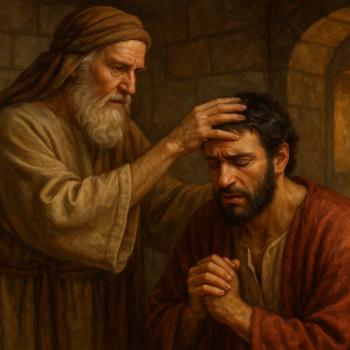Jesus’s parable about the return of seven spirits is situated after Matthew’s version of blaspheming the Holy Spirit and similar judgment teachings (Matthew 12:43–45; and parallel in Luke 11:24–26). The term “unclean spirit” is a Jewish way of referring to demons. How is it that this demon who was cast out of a person can return with reinforcements to possess that person again making him seven times worse? Does this refer to vulnerabilities related to backslidden Christians? 
The Teaching of Matthew 12:43-45
In this text Jesus says regarding the unclean spirit that once it is cast out, it goes into dry regions (the desert) and finds no rest. Returning to its former host, it finds the “home” swept and put in order. Matthew’s version has the house “empty” (σχολάζω). The implication may be that the unclean spirit can enter back inside the house due it being unoccupied. This house seems to be a metaphor for the human body. The demonic spirit brings along seven other spirits more wicked than itself, and together they possess the individual so that the person’s latter state is worse than the former.
The Interpretation of Becoming 7 Times Worse than Before
The passage doesn’t actually say that the person becomes seven times worse. Interpreters draw that inference based on the assumption that seven evil spirits would make the possessed person seven times worse. But this does not necessarily mean that the person will now do seven times the amount of wicked activities as before. The text possibly describes how an individual or people could become more calloused to the things of God than before. In essence, the idea of becoming “worse” (Matt 12:45) and having one’s spiritual insight “taken away” (Matt 13:11–12) are conceptually close. They both communicate obduracy (a hardened heart) toward God’s kingdom and messenger.
If we interpret the number seven figuratively here, it may refer to complete apostasy. It points back to the unpardonable sin (Matt. 12:30–32), forward to spiritual obduracy (Matt. 13:11–15), and anticipates the coming judgment on those who refuse to believe the message and ministry of Jesus (Matt. 12:36–42).
It is also significant that this parable follows on the heels of Jesus declaring that judgment awaits this evil and adulterous generation that seeks for a sign (Matt 12:38–42). The interpretation takes on a corporate dimension here. It implies that Jesus’s opponents among the religious leaders fail to recognize that his healings in their midst are sanctioned by God and done by the power of God’s Spirit. His miracles authenticate his message and ministry, and so there is no reason for them to ask for other signs. In this sense those belonging to the wicked generation represent a relapsed demoniac. As a corporate group they have been “cleansed” of demonic forces because of the ministry of Jesus. But because they are rejecting him they will find themselves worse off than before.[1]
Layers of Meaning in Matthew’s Gospel
Typical of parables, this teaching seems to have more than one layer of meaning depending on the audience:
First, Matthew and his community probably would make the story applicable to the false prophets who cast out demons in Jesus’s name. Jesus does not acknowledge them at final judgment (see Matt. 7:21-23). Their successful exorcisms, in any case, are only temporary. The demons return and reenter the vacant body.
Second, later Christians perhaps understood the parable as a warning for those who convert to Christianity but then fall away. If they do not remain spiritually alert, they could find themselves backslidden and their “last state” would be “worse than the first” (see examples in 2 Peter 2:20; 1 Clement 46:8; Hermas Similitudes 9.17:5–18:2; Visions 4.2; Apocalypse of Peter 3; Irenaeus Heresies 4.27).
Third and finally, perhaps Jesus originally spoke these words as a way of cautioning those who were formerly demon possessed. It is not enough that he healed them; they must also believe the teachings of Jesus and follow him. If their body or “house” is not occupied with his teachings, they might find themselves in a worse state than before. As such, the original purpose of Jesus’s words served as warnings for those whom he personally healed. They must not neglect his teachings or else they might find themselves in a worse condition than before.
Take Home Conclusion
Biblical scholar Joachim Jeremias put it well regarding this parable: “The relapse is not something predetermined and inevitable, but something for which the man himself is responsible. The house must not remain empty…. A new master must reign there, the word of Jesus must be its rule of life, and the joy of the Kingdom of God must pervade it.”[2] For Jeremias, logically speaking, Matthew 12:44 is intended to be conditional—“if the demon returns and finds the house empty, in that case he will return with sevenfold reinforcements….”[3]
So then, what’s the take home point? A change needs to take place for those who are set free from demonic or sinful strongholds by the power of Christ. They must now follow Jesus and be loyal to his teachings. If they reject such things after deliverance, they might find themselves in a worse predicament than before.
Notes
[1] On corporate judgment related to this passage, see Ulrich Luz, Matthew 8–20. Hermenia (Minneapolis: Fortress, 2001), 221. For a more elaborative account of this parable and on apostasy in general, see B. J. Oropeza, In the Footsteps of Judas and Other Defectors. Apostasy in the New Testament Communities, vol. 1 (Eugene: Cascade Books, 2012).
[2] Joachim Jeremias, The Parables of Jesus (London: SCM, 1972), 198.
[3] Joachim Jeremias, New Testament Theology (New York: Scribner, 1988), 154.
Image: Wooden Figure Stones Struggle For Life Resistances, via pixabay.com














